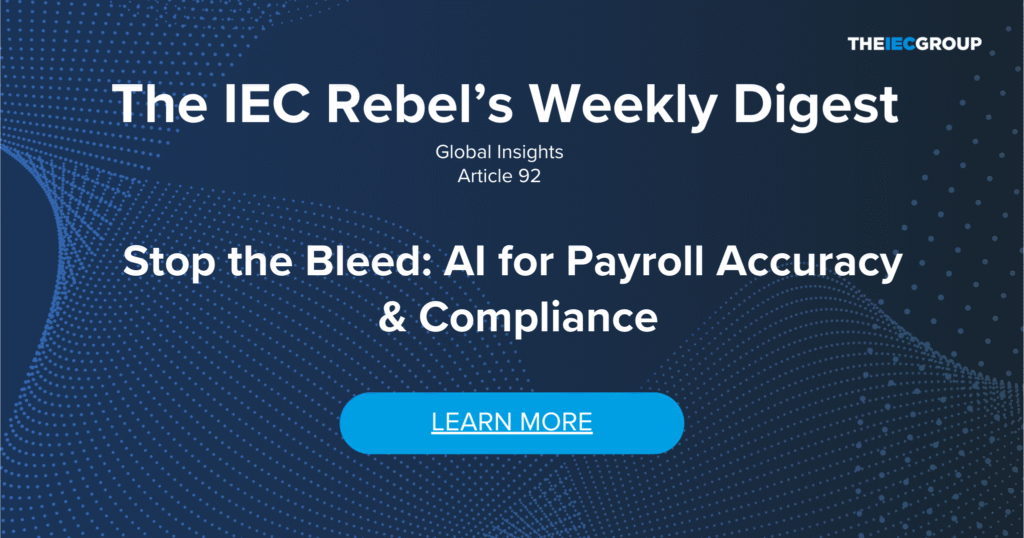Payroll is where AI either delivers—or breaks trust.
Executive Summary
 This article dives into as the most unforgiving corner of AI in Workforce Operations & Pay. We explore how AI is already transforming the full chain: scanning regulatory changes across countries, translating them into actionable rules, catching anomalies before payroll closes, reconciling messy data feeds, and generating audit-ready evidence instead of last-minute panic packs.
This article dives into as the most unforgiving corner of AI in Workforce Operations & Pay. We explore how AI is already transforming the full chain: scanning regulatory changes across countries, translating them into actionable rules, catching anomalies before payroll closes, reconciling messy data feeds, and generating audit-ready evidence instead of last-minute panic packs.
You’ll see where AI genuinely adds value today: pre-payroll validation, error and fraud detection, continuous controls, and copilots that explain payslips and deductions in plain language while still keeping humans firmly in charge. We also unpack the dark side: hallucinated “legal” answers, privacy and cross-border data risk, biased anomaly flags, and the dangerous illusion that “the system” is now accountable instead of the employer.
Along the way, we call out what good looks like for vendors and buyers: secure-by-design architectures, transparent rule logic, human-in-the-loop governance, and AI that reduces compliance risk rather than just speeding up bad processes.
We invite HR, WFM, Operations and Payroll leaders – and solution providers – to participate in the study and help define the next generation of AI in Workforce Operations & Pay.
Study #2: AI in Workforce Operations & Pay – Category spotlight: AI for Payroll & Compliance
Intro: Payroll is the last place where business cosplay goes to die.
You can wing your way through half-baked talent tech. You can “pilot” a DEI dashboard that nobody trusts. You can even survive a messy ATS rollout if you squint hard enough. But payroll? Payroll does not forgive. If people don’t get paid correctly, on time, and in line with local law, every shiny HR transformation you’ve pitched turns into a meme.
That’s why Study #2 hits different. AI in Workforce Operations & Pay isn’t about headline-grabbing “future of work” theater. It’s about the operational core: schedules, time, pay, taxes, benefits, equity, allowances, statutory filings, and the compliance machine that keeps multinationals from bleeding money or ending up on the wrong side of regulators.
And within that, AI for Payroll & Compliance is the category with the most immediate value density — because payroll is where three storms collide:
- Exploding cross-border complexity. More countries, more worker types, more pay elements, more policy exceptions.
- Regulatory volatility. Labor, tax, social security, reporting and pay transparency rules shifting faster than your vendor’s release notes can keep up. AI-enabled payroll platforms are now explicitly positioning themselves as “real-time compliance engines.”
- A new AI toolchain. We’ve moved from rule-based automation (RPA) into systems that can interpret, extract, predict, and converse. That changes payroll from a back-office calculator into a decision layer.
Let’s unpack what that actually means in the field — the use cases that matter, the traps that bite, and how maturity plays out when AI meets the world’s most unforgiving HR function.
What “AI for Payroll & Compliance” really covers
In mature organizations, the payroll stack is already a Frankenstein of local providers, global aggregators, HRIS feeds, time systems, benefits platforms, equity managers, and finance ERPs. AI doesn’t replace that overnight. It wraps around it and starts removing friction where humans currently babysit the process.
From the study lens, the category clusters around five high-impact jobs:
1) Compliance radar: “Don’t make me read 400 pages of new tax guidance.”
The first killer use case is regulatory change ingestion. AI tools monitor updates from governments, tax bodies, and labor authorities, then map those changes to your payroll logic and alert you to impact.
Where this goes beyond old-school “legal newsletters” is speed and structure:
- auto-tagging changes by country, topic, payroll element
- summarizing in plain language for payroll ops
- proposing configuration deltas
- flagging conflicts with your internal policies
Important reality check: AI can surface and organize legal change. It cannot be your legal sign-off. Anyone promising “fully automated compliance decisions” without human accountability is selling you a lawsuit.
2) Accuracy & anomaly detection: “Find the needle before it becomes backpay.”
Payroll errors are rarely dramatic. They’re death by a thousand tiny leaks: wrong tax table, duplicate allowance, outdated exchange rate, overtime misclassified, retro-pay missed.
ML-driven anomaly detection spots outliers versus historical or peer patterns:
- sudden net-pay swings
- implausible overtime patterns
- duplicates in pay elements
- allowance spikes tied to a specific HRIS feed
- mismatches between time and payroll records
This is where AI consistently reduces error rates and rework, the most reported ROI theme in market evidence.
3) Pre-payroll validation & auto-reconciliation
Think of this as AI-powered “staging checks.” Before payroll closes, the system reconciles data across sources and predicts which files will fail.
Example checks AI does well:
- time feed vs. contract rules vs. local overtime law
- benefits deductions vs. eligibility windows
- equity vesting events vs. taxable payroll periods
- exchange rates vs. payroll cutoffs
- headcount movements vs. statutory filings
The magic isn’t just catching errors — it’s ranking risk so humans focus where the real blast radius sits.
4) Case management copilots & employee self-service
Payroll teams lose insane time answering the same questions:
“Why is my net pay lower this month?
“What’s this deduction?”
“How do I change my tax class?”
“When is my bonus taxed?”
LLM copilots read payslip data, policy docs, and country rules to draft responses, open tickets, or guide employees through workflows. Vendors are framing this as a trust win if it’s done responsibly.
5) Audit trail & evidence generation
Compliance isn’t only about being right — it’s about proving you were right.
AI is increasingly used to:
- auto-compile audit packs
- generate narratives (“why this adjustment happened”)
- map controls to transactions
- run continuous control tests rather than annual panic mode
This turns audits from episodic pain into always-on hygiene.
The uncomfortable stuff: risks you can’t outsource to “the AI”
AI in payroll lives inside the most sensitive data perimeter you have: identities, compensation, banking, tax status, family situation, performance-linked awards, and sometimes medical or union deductions.
So yes, you get automation. And you also inherit new failure modes:
- Hallucinated legal interpretations. LLMs can summarize a regulation beautifully — and still be wrong. Never allow autonomous legal conclusions without guardrails and review.
- Data privacy and cross-border risk. Payroll data often can’t leave jurisdictional boundaries. Any “global AI layer” must be explicit about storage, processing zones, and redaction of PII.
- Bias and fairness spillover. If AI flags “anomalies” without context, it can accidentally encode bias (e.g., treating certain allowances as suspect because they’re common in a subgroup). Responsible AI practice in payroll is now a forefront topic.
- Shadow automation. Teams building ad-hoc bots and spreadsheet macros with AI on the side = invisible compliance debt.
- Accountability illusion. Even if your vendor “updates rules automatically,” regulators will still hold you responsible. The employer is the liable entity, not the algorithm.
So the rebel take is simple: use AI to shorten the distance between change → detection → action — but never to erase accountability.
Maturity levels 1–5 for AI in Payroll & Compliance
Here’s the staged maturity ladder most organizations are living through right now. CMMI defines levels 1–5 as the path from chaotic to optimizing.
We’re applying that logic to AI in payroll.
Level 1 — Initial: “AI-curious, process-fragile.”
- Payroll is correct mostly because heroic humans are compensating for fragile inputs.
- AI shows up as experiments: chatbots answering FAQs, maybe a pilot anomaly report.
- Compliance tracking is manual or vendor-newsletter driven.
- Data is inconsistent across countries and providers.
Smell test: if payroll accuracy depends on who is on vacation, you’re here.
Level 2 — Managed: “Point automation with guardrails.”
- AI is used in narrow steps: pre-payroll checks, anomaly flags, auto-coding of cases.
- A single owner (or small CoE) manages models and rules.
- Compliance updates feed into workflows but still need manual configuration.
- Basic KPIs exist (error rates, late filings), but not predictive.
Win: fewer avoidable errors.
Risk: tools are fragmented, not yet systemic.
Level 3 — Defined: “AI embedded in standardized global payroll.”
- Global payroll data model is standardized (even if providers differ).
- AI workflows are documented and repeatable.
- “Human-in-the-loop” is designed, not accidental.
- Compliance knowledge base is centralized, and AI summarizes impact consistently.
- Security/privacy rules for AI are formalized.
Crucial shift: process discipline now shapes AI quality.
Level 4 — Quantitatively Managed: “Predictive control at scale.”
- AI scores payroll runs by risk before close.
- Predictive alerts for audit, misclassification, or filing exposure.
- Continuous controls monitoring with real metrics:
- error frequency by element/country
- compliance latency (time from law change → config live)
- cost-of-noncompliance estimates
- Cross-functional dashboards connect HR, payroll, finance.
This is where payroll becomes a strategic sensing system.
Level 5 — Optimizing: “Closed-loop, self-improving compliance ops.”
- AI recommends and auto-drafts rule changes, routing for approval.
- Payroll is simulated in advance for scenario planning (bonus waves, shift impacts, new-country entry).
- Root-cause learning: every error improves the model.
- Employee copilots resolve most Tier-1 questions end-to-end.
- Compliance becomes proactive: you see risk trends before they hit filings.
North star: payroll as an adaptive, self-correcting network — not a monthly fire drill.
The no-nonsense playbook to move up the ladder
If you want to jump maturity levels without a multi-year detour, here’s the path that actually works:
- Fix the data spine first.
AI doesn’t make dirty payroll data smarter. It makes it louder. Standardize pay elements, employee attributes, and time inputs.
- Pilot where regulation hurts most.
Start in countries with high volatility or complex payroll elements. That’s where compliance radar and anomaly detection pay back immediately.
- Design accountability into the workflow.
Define who approves AI-suggested rule changes, and within what SLA. Automation without RACI is just outsourced confusion.
- Go “secure-by-default.
Use least-privilege access, PII masking, jurisdiction-aware processing, and explicit retention rules. If your vendor can’t explain their AI data boundaries in plain language, pause.
- Measure ROI in risk, not only hours.
Reduced rework matters — but so do avoided penalties, audit friction, and reputational damage.
- Upskill payroll into AI supervision.
The future payroll pro is half compliance operator, half model-trainer. You need people who can question outputs, validate edge cases, and refine rules.
Where the category is heading
The early hype cycle was “AI will do payroll.” The grown-up reality is better:
AI will make payroll a living compliance system.
Expect convergence of three trends over the next 12–24 months:
- LLMs fused with rules engines (so genAI can’t freestyle on tax law).
- Real-time compliance monitoring across multi-country payroll.
- Payroll-driven workforce insights flowing to CFO/CHRO decisions.
That’s not sexy. It’s powerful.
Because when payroll and compliance are continuously intelligent, Workforce Ops & Pay stops being a cost center — and becomes a control tower for global growth.
Rebel close
AI for payroll and compliance isn’t optional tech garnish. It’s the difference between scaling globally with confidence or scaling with a ticking liability bomb.
Most companies are somewhere between Levels 1 and 2: experimenting, automating slices, still dragging a manual compliance tail.
Your mission in Study #2 terms:
- standardize the spine (Level 3)
- predict the risk (Level 4)
- close the loop (Level 5)
Do that, and payroll becomes the quiet superpower of your operating model — the place where AI doesn’t just optimize work, but protects trust.
Take part in the study, share your use cases and pain points, and get early access to the IEC Dynamic Map Quadrants for AI in Workforce Operations & Pay. If you’re building the next generation of AI for payroll and compliance, don’t just ship features — show leadership. Join the study, share your strongest use cases and pain points from the front line.
Closing note & invitation
 Provider comparisons—and the identification of the leading AI provider in Talent Acquisition—will be a core part of the first global IEC study on “AI in Talent Management and Development.” Participants are invited to join free of charge.
Provider comparisons—and the identification of the leading AI provider in Talent Acquisition—will be a core part of the first global IEC study on “AI in Talent Management and Development.” Participants are invited to join free of charge.
Participation: pm@theIECgroup.com
Study scope (AI-first lens):
Study #1: AI in Talent Intelligence & Development
- AI-Driven Talent Acquisition
- Performance & Talent Intelligence
- Learning & Development (incl. internal mobility/marketplaces)
Study #2: AI in Workforce Operations & Pay
- AI in Scheduling & Time Management
- AI for Payroll & Compliance
- Total Workforce Orchestration (VMS/FMS, contractors, EOR)
Study #3: Employee Experience & People Insights
- Employee Experience & Virtual Assistants
- Workforce Analytics & Planning
Over the next few weeks, we’ll zoom into each of the eight categories in IEC Rebel’s Digest—one deep dive at a time, with practical use cases, KPIs, and the vendor patterns to watch.
IEC Rebel’s Digest— The IEC Group can help you audit your global employment setup by identifying labor leasing risks, verifying licensing requirements, and ensuring your EOR partners meet every compliance standard—before regulators come knocking.
Last but not Least: If you’re facing challenges and wondering how others are managing similar issues, why not join The Leadership Collective Community? It’s a peer group and webcast platform designed for leaders to exchange insights and experiences.
Introducing the IEC Knowledge Network Free Membership – Your Gateway to Seamless Access!
We are thrilled to present a new service that goes beyond the ordinary download experience. In addition to offering you the ability to download the things you love, we are delighted to introduce the IEC Knowledge Network Free Membership.
The Free Membership option grants you access to our library of articles and videos, without the need for tedious registrations for each piece of content.
The publication serves as a trusted resource to support executives in their pursuit of sustainable and successful global expansion. In addition the IEC Practitioners are available to discuss your specific challenge in more detail and to give you clear advise..
Take advantage of this valuable resource to accelerate your global expansion journey


